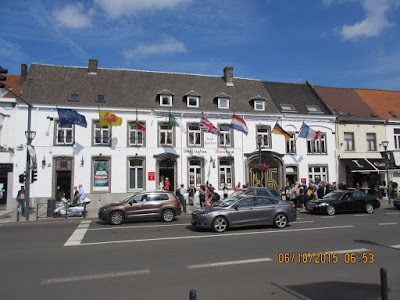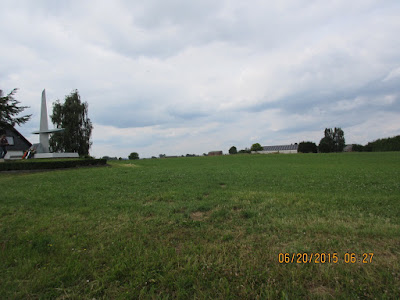First, here are some images of the 150th Anniversary of the Battle of Waterloo, as celebrated at the Duke of York's Headquarters in Chelsea, London, in 1965. My father kindly took my brother and I to attend this amazing event. For me, this was a life-changer. As a 12 year old, I was so impressed by the grandeur of Peter Gilder's model battlefield and rank upon rank of well painted metal figures it created in me a life-long interest in history, figure collecting and wargaming.
50 years later, my brother Clive and I decided to attend the 200th Anniversary of the Battle of Waterloo, not at a war game recreation but on the Belgian battlefield itself. What follows is a photo essay of that trip, organised by The Cultural Experience who did an excellent job and took care of everything. Whatever the difficulties created by such a vast crowd of attendees, the tour leader and historian/guide on the trip sorted things out as best they could. We really enjoyed them and all of our fellow guests. I highly recommend the Cultural Experience.
We arrived on the day of the battle, June 18th 2015. The tour started in the village of Waterloo at Wellington's Headquarters during the battle, now a museum.
At the back of the house is a small garden with various memorials to the officers who died at the HQ
during or after the battle.
We saw the recreation of the Waterloo Dispatch being sent to London in this coach. An honour guard of the Coldstream Guards presented arms.
We started the second day on the battlefield at the Château d'Hougoumont. This has seen extensive restoration in preparation for the 200th Aniversary. Although it now looks better than the delapidated structures of a few years ago, it is not a very perfect restoration as you will see from the mismatched bricks and tile and the brand new wooden gate.
After Hougoumont, we took a quick initial look at the Allied encampment. Due to universal demand from our fellow guests, the tour organisers arranged a much more complete visit on the next day. The sight of large numbers of re-enactors drilling on the British ridge was thrilling.
La Haye Sainte is in much better shape and has required less drastic restoration.
The first day's battle re-enactment took place on the site of D'Erlon's attack. The battle area was quite large and therefore only visible with binoculars, even before black powder smoke made observation almost impossible.
When the French Grand Battery started firing, we could only obtain glimpses of the battle through the dense smoke.
On the third day, we started with our more detailed look at the Allied Encampment.
In the afternoon we visited Ligny, starting in the town itself.
Here are more pictures of the second "battle". It was billed as a different part of the historical battle but was in fact identical to the day one battle.
This is how much of the battle appeared once the black powder smoke started to fill the valley.
We ended the tour visiting various monuments in Brussels.
We concluded the visit by touring the Emperor's Headquarters at le Ferme de Caillou. This houses a very interesting museum. It also served as the French encampment during the recreation of the battle.
In conclusion, Clive and I really enjoyed the trip. The Cultural Experience team was excellent. I wanted to do this trip to complete my 50 year study of the battle. Just a word of caution: historical re-enactments are great experiences for the re-enactors. However they are difficult to appreciate and enjoy as audience members. Although the Belgian authorities made a few mistakes, the problem is inherent to the event. For a really large re-enactment such as Waterloo, it just is not possible to provide good viewing opportunities of the battle re-enactment. That said, the encampments were so good, they more than made up for any disappointment with the battle itself.


























































































































